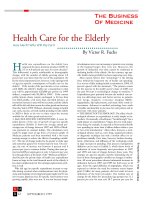Who should pay for higher education questions
Bạn đang xem bản rút gọn của tài liệu. Xem và tải ngay bản đầy đủ của tài liệu tại đây (192.72 KB, 7 trang )
Centre of Communication & Design – Academic English Program
Who should pay for higher education – and how?
viewed 24.2.12
Bahram Bekhradnia
We have moved very rapidly in England from a situation where full-time undergraduate students paid nothing
towards the cost of their higher education – that was the case until 1998 – to a position where students will in
future pay 100% of their costs. That is the apparent effect of the new student finance regime that has been
proposed by the government. Given that the philosophical basis for the introduction of fees in the first place
was that the benefits of higher education should be shared between the state and the student, and therefore
that it was right that the student should contribute to the cost, the implication of the state making no
contribution would, on this logic, be that all the benefit is private, and that the state receives no benefit from
educating graduates.
That would be the case if it were true that the state is not contributing anything to the cost of higher
education. In fact, that is not the situation. What has changed is the basis on which the state will in future
make its contribution, because the state will continue to contribute, just in a very different way. Additionally, it
is possible – in fact the government claims that it is the case – that the balance between the amounts
contributed by the state and the individual could change radically again at some point. At present higher
education institutions (HEI’s) receive grants directly from the government, through its intermediary the Higher
Education Funding Council for England (HEFCE), and it also subsidises the loans that it provides students in
order to pay their fees – subsequently being repaid through what is effectively a higher tax on the salaries of
graduates.
In future the government has decided that it will not provide grants directly to universities but will provide
funds to universities only by subsidising loans to students which they use to pay fees. This is a major ideological
shift. It is presented by the government as increasing choice for students and providing funding to universities
only insofar as students exercise choice and choose to go to that university, so also improving the incentive to
provide high-quality education, be customer focused and so on. It is classic market economics. The reality
though is that universities at present are funded only to the extent that they recruit students (that is the basis
on which the government grant is given to universities). It could be that there will be some shift in the
psychological state of students as they pay the money to universities themselves instead of the government,
but even that is unknown. But it is highly debatable whether student choice will be affected at all. Nor is it at
all likely that the government will achieve the sort of savings that it has claimed will accrue because of its
withdrawal from providing grants directly to universities. As part of the package that included increased
student fees and reduced government grant, the government has increased the maximum fee that universities
may charge and with it the loans that it must provide to students. Additionally, at the same time it has reduced
the amount that students must repay each month – despite the fact that they will have larger loans – while
increasing the interest rate that they must pay, as well as the length of time over which they must pay as well.
The balance is likely to be that an awful lot of people who take loans will not repay their loans in full. Consider
too that the government’s financial calculations were based on assumptions that average fees would be
£7,500, whereas the reality appears to be that few universities will charge below that level.
Created by Karen Adam
/storage1/vhost/convert.123doc.vn/data_temp/document/pux1476532115-2609767-14765321157372/pux1476532115.docx
Centre of Communication & Design – Academic English Program
This means that the average will be much higher and therefore the cost to the government of the loans that it
must make will be much higher too, all resulting in a recipe for much higher costs to the government than it
had assumed.
There is no doubt that the government is in difficulty, and that the difficulty is born of ideology. The reality is
that so long as loans are subsidised, the amount of loans that are taken, and the rules for paying back the
loans, will make a difference to public expenditure. The government has to either moderate the level of the
fees (and therefore the total amount of loans that it has to provide), or it has to regulate the number of
students that are eligible for such loans. That is going to be a problem not just for this government in this
country, but wherever this approach to funding is adopted.
The way that this government – and perhaps others following a similar path –thought that they would curb the
level of fees was through straightforward market competition. Some universities would be unable to charge
high fees because students would shun them and go to other universities which either had higher quality or
better reputations, or lower prices. There are a number of problems with this approach. First, higher education
is not a market like other markets. Higher education is a positional good, and it is not at all clear that there is
the same sort of price elasticity in higher education as elsewhere. No doubt because of the changing job
market where degrees are essential, students seem to be prepared to pay to go into higher education even
though prices rise. A trebling of the fee in 2006 made no difference to demand. Allied to this is the fact that the
government has set a price limit – the maximum fee is £9,000 - which narrows the band within which
competition might take place. An oddity about higher education and the market is that there is some evidence
that price is seen as a proxy for quality, which provides a disincentive for universities to reduce prices – as they
might be seen as second rate. And finally, and perhaps most important, there is every indication that there is a
large latent demand for higher education, and so even if some universities that have higher prestige take more
students, those with less prestige are likely still to find that they have customers, even at prices that might
seem at odds with their position in the market. And that is why it is likely that the UK government will try to
curb the number of people eligible for higher education – it will try to find a means of reducing the demand,
and so force universities that do not have the reputation of some of their peers to compete for a limited
market on the basis of price. These are extraordinary times, and the tectonic changes that are being
introduced, almost haphazardly, are quite extraordinary. The stakes are high, and we are about to leap into the
dark. What is certain however is that students of the future will pay a lot more for their education than in the
past, and it could well be that opportunities to go to higher education are reduced as well. That does not sound
like a good future outcome.
Bahram Bekhradnia is Director of HEPI, was formerly the Director of Policy at HEFCE for ten years and has advised twenty
different national governments on the financing of higher education.
The Higher Education Policy Institute (HEPI) is the UK’s only independent think tank devoted exclusively to higher
education. Founded in 2002, HEPI has built up a strong reputation for robust and objective policy analysis and advice
across a whole range of higher education issues. Its mission is to improve higher education in the UK by creating a better
informed policy environment - informed by research and analysis, as well as drawing on experiences from other countries.
Created by Karen Adam
/storage1/vhost/convert.123doc.vn/data_temp/document/pux1476532115-2609767-14765321157372/pux1476532115.docx
Centre of Communication & Design – Academic English Program
1.
Skim read the text to find the words in bold. Try and guess the meaning of these words by
context and match the definition on the right with the word on the left:
a) Regime (n)
a) Something given
b) Implication (n)
b) to purchase the assistance of by the
payment of a subsidy
c) Contribution (n)
c) open to question; in dispute; doubtful
d) Radically (adv)
d) a ruling or prevailing system
e) Subsidises (v)
e) the body of doctrine, myth, belief, etc., that
guides an individual, social movement,
institution, class, or large group
f) Ideological (adj)
f) the person so authorized; substitute; agent
g) Incentive (n)
g) something implied or suggested as naturally
to be inferred or understood
h) Debatable (adj)
h) flexibility; resilience; adaptability
i)
eligible (adj)
j)
elasticity (n)
k) proxy
i)
thoroughgoing or extreme, especially as
regards change from accepted or traditional
forms
10. something that incites or tends to incite to
action or greater effort, as a reward
offered for increased productivity
11. fit or proper to be chosen; worthy of
choice; desirable
2. Now make a note of the words and their word families in your Vocabulary Dictionary.
TIP: To ‘own’ a word, you need to use it! Try and use this new vocabulary in
your next essay or tutorial. Make sure you check out the pronunciation of
any new words by going to and listen to the
pronunciation audio. This will also help you recognize this vocabulary when
you hear it too!
Created by Karen Adam
/storage1/vhost/convert.123doc.vn/data_temp/document/pux1476532115-2609767-14765321157372/pux1476532115.docx
Centre of Communication & Design – Academic English Program
3.
4.
To practice using some of these words, make sentences below using the words on the
left:
a)
CONTRIBUTION
b)
SUBSIDY
c)
DEBATE
d)
ELIGIBLE
Read the article & answer the following questions:
1. Which country does the article refer to?
2. When did free university education in England stop?
3. How much of their fees, will students have to pay in future?
4. Why were university fees introduced?
5. Does the state no longer contribute to the cost of higher education?
6. Where do higher education institutions receive grants from?
7. Where will students get money from to pay for their fees in future?
8. Is it likely that the UK Government will achieve the savings they expected by increasing student fees?
9. Will the increase in fees lead to more or less costs for the Government?
10. How much did university fees increase by in 2006?
11. Did this increase lead to a decrease in demand for places?
12. What action may the Government do in the future?
13. What is likely to happen to students in the future?
Created by Karen Adam
/storage1/vhost/convert.123doc.vn/data_temp/document/pux1476532115-2609767-14765321157372/pux1476532115.docx
Centre of Communication & Design – Academic English Program
5. Review the text and answer the following credibility / organisation questions:
1. Who is the author of the text? What qualifications / experience does the author have?
2. Where can you find this article?
3. What is the purpose of this article?
4. What is the broad topic of this article? What is the focus of this article?
5. What did you already know about this topic? What is the situation in your country? Are universities public or
private? Are fees expensive?
6. Is the article credible (i.e. believable / possible)? Why / why not?
7. How has the author organised the article? Identify the various elements (e.g. anecdotes / opinions / negative
& positive effects / advice & suggestions / methodology / solutions / the future / history etc.). Is it logically
organized?
6.
Read the text again but this time annotate, then make a critical response to the article
in your Response Journal.
Make sure you reference the article using the Harvard Referencing System.
Summarise the main points of the article in the left-hand column.
Note your ideas to this article in the right-hand column.
If this article raises more questions than it answers, can you find other articles to help you answer those
questions?
5. Can you find any other articles that offer an opposing view?
1.
2.
3.
4.
7.
Look at the tutorial questions for this week. How can this article help you to respond
to the questions:
1. Why do people go to university?
2. Should everyone go to university?
3. Who should pay for university education?
Created by Karen Adam
/storage1/vhost/convert.123doc.vn/data_temp/document/pux1476532115-2609767-14765321157372/pux1476532115.docx
Centre of Communication & Design – Academic English Program
ANSWERS:
1. Skim read the text to find the words in bold. Try and guess the meaning of these words by
context and match the definition on the right with the word on the left:
a) Regime (n)
1.Something given
b) Implication (n)
2.to purchase the assistance of by the payment
of a subsidy
c) Contribution (n)
3. open to question; in dispute; doubtful
d) Radically (adv)
4.a ruling or prevailing system
e) Subsidises (v)
5. the body of doctrine, myth, belief, etc.,
that guides an individual, social movement,
institution, class, or large group
f)
6. the person so authorized; substitute;
agent
Ideological (adj)
g) Incentive (n)
7. something implied or suggested as
naturally to be inferred or understood
h) Debatable (adj)
8. flexibility; resilience; adaptability
i)
eligible (adj)
9. thoroughgoing or extreme, especially as
regards change from accepted or traditional
forms
j)
elasticity (n)
10. something that incites or tends to incite to
action or greater effort, as a reward
offered for increased productivity
k) proxy
11. fit or proper to be chosen; worthy of
choice; desirable
Created by Karen Adam
/storage1/vhost/convert.123doc.vn/data_temp/document/pux1476532115-2609767-14765321157372/pux1476532115.docx
Centre of Communication & Design – Academic English Program
4.
Read the article & answer the following questions:
1. Which country does the article refer to?
England
2. When did free university education in England stop?
1998
3. How much of their fees, will students have to pay in future?
100%
4. Why were university fees introduced?
Philosophical belief that cost should be shared between the state and the student.
5. Does the state no longer contribute to the cost of higher education?
No it still contributes
6. Where do higher education institutions receive grants from?
From the government via the Higher Education Funding Council for England (HEFCE)
7. Where will students get money from to pay for their fees in future?
Loans from the HEFCE
8. Is it likely that the UK Government will achieve the savings they expected by increasing student fees?
No
9. Will the increase in fees lead to more or less costs for the Government?
More costs (loans increased / reduced monthly repayment / extended time to pay)
10. How much did university fees increase by in 2006?
They trebled
11. Did this increase lead to a decrease in demand for places?
No
12. What action may the Government do in the future?
Reduce the number of people eligible for higher education / reduce the demand
13. What is likely to happen to students in the future?
They will have to pay more / student numbers reduce as less opportunities for higher education
Created by Karen Adam
/storage1/vhost/convert.123doc.vn/data_temp/document/pux1476532115-2609767-14765321157372/pux1476532115.docx









